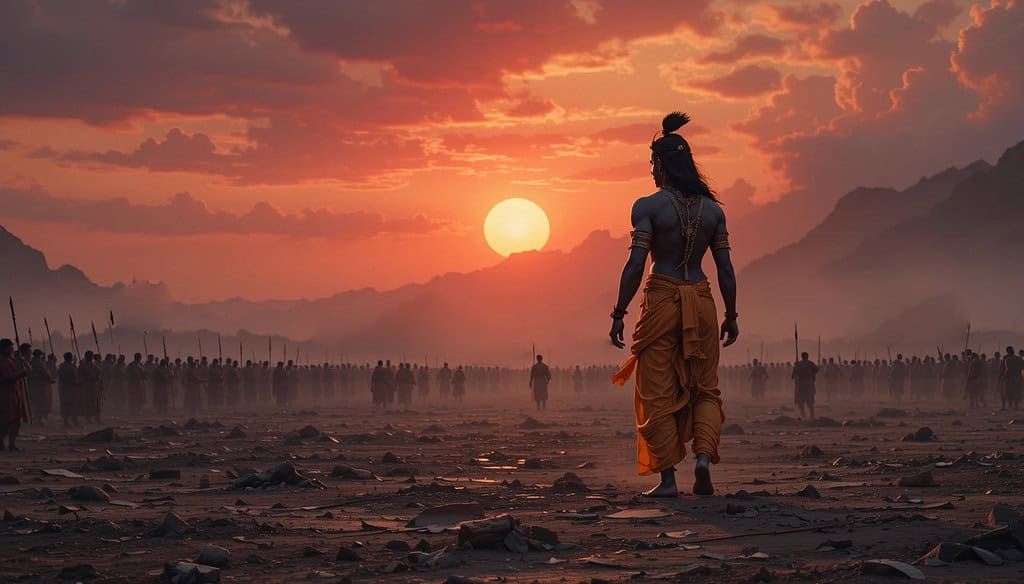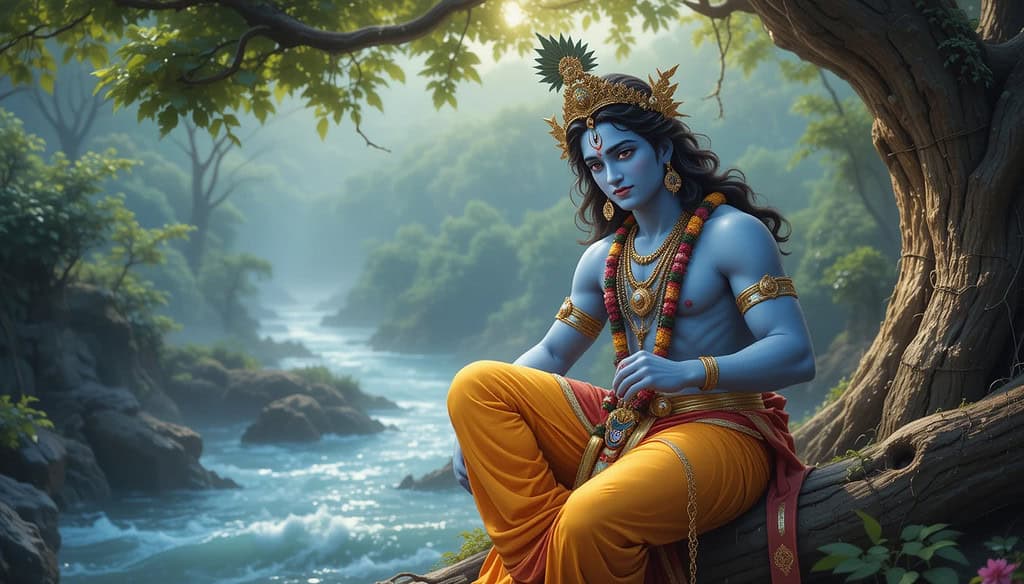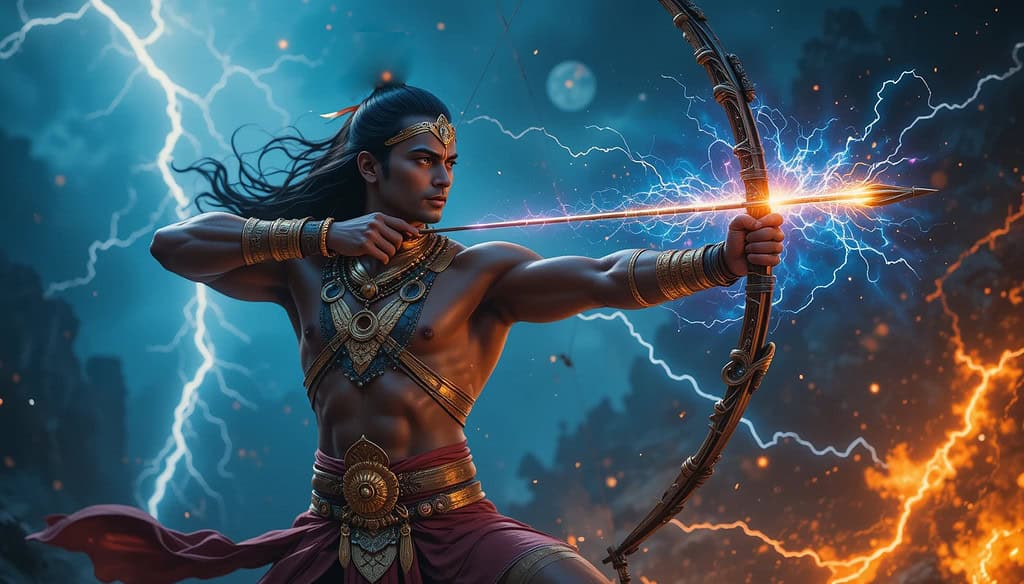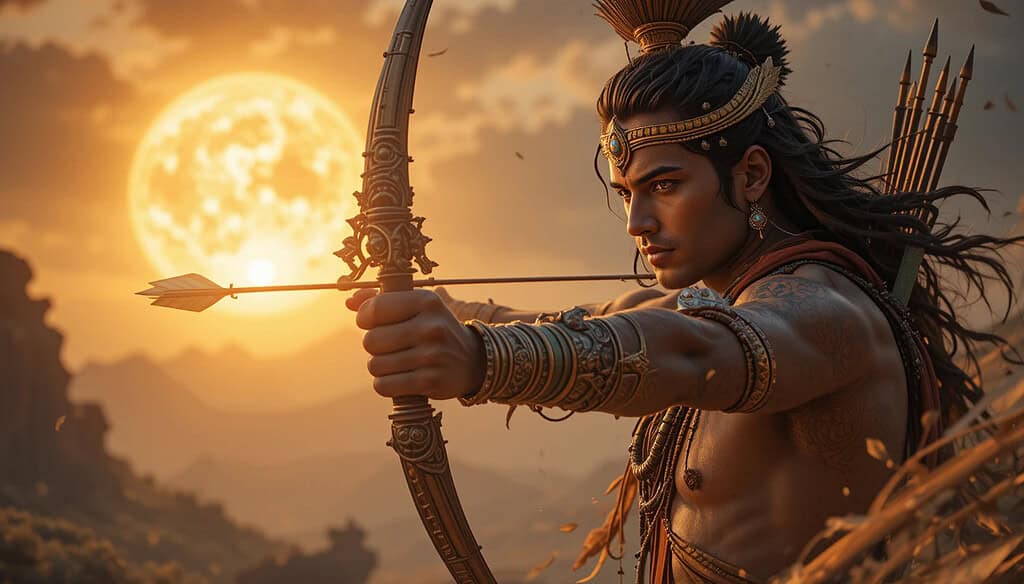Table of Contents
Introduction: The Timeless Storytelling of Mahabharata

The Mahabharata is one of the greatest stories that is ever told. It is the longest epic poem known to mankind. It has over 200,000 individual verse lines. The story of Mahabharata is filled with human struggles, ambitions, and tragedies. Its characters are flawed and yet they are unforgettable. Its conflicts are profound. Many ancient tales have faded with time. But the Mahabharata stands tall. It continues to be retold and adapted. This is because its storytelling is not just effective, it is genius.
The Mahabharata is not considered just literature, but it is regarded as history. The writer of this epic, Veda Vyasa aka Krishna Dvaipayana, called it ‘i-ti-hasa’, meaning “as it happened”. The Mahabharata does not unfold in a simple, straightforward manner. It shifts between past, present, and future. It tells stories within stories. It offers different perspectives on the same events. Its characters are not just protagonists or antagonists. They are real. They have both strengths and weaknesses. Every choice that they make leads to consequences. These choices and resulting consequences have far-reaching effects on the history of India and the World.
This article does not discuss the Mahabharata’s spiritual or religious aspects. Instead, it focuses purely on its storytelling. The techniques used in this epic have shaped literature, theater, and cinema for thousands of years. They add depth to the story, making it more than just a tale of war and duty. They turn it into a narrative masterpiece. These unique storytelling techniques of the Mahabharata explore fate, morality, and human nature.
In the next section, we will explore six of these storytelling techniques. Each of them plays a role in making the Mahabharata an epic tale. Its brilliance is not just in what it tells, but in how it tells it.
6 Genius Storytelling Techniques of Mahabharata

1. Layered Narratives: Stories Within Stories
The Mahabharata is not a single story. It is many stories structured together. The tales of the Mahabharata are constructed in multiple layers. One tale leads into another. They reveal new truths and perspectives. This layered narrative makes the epic feel alive. It gives this epic tale complexity and depth.
The story of Mahabharata begins with a simple telling. But soon it turns in a different direction with a broadened perspective. A sage tells the story to a king. That king tells it to another. A disciple listens and retells it elsewhere. Within these retellings, characters narrate their own pasts, victories, and failures. A warrior may pause to tell a story of a past battle. Then within that tale, another character may recall an older story. The story has the power to shape their fate. This way the story goes deeper and more layers emerge.
This structure is not just for effect. It serves a purpose. It creates a sense of continuity. It shows that the events are passed down through generations. It hides the line between past and present. It makes the readers or listeners ponder about duty, morality, and righteousness. Every narrator brings a perspective and bias. Different narrators narrate the story in certain ways.
This technique keeps the Mahabharata from being a simple war story. It becomes a collection of human experiences. It transforms itself into an epic journey of love, revenge, loss, and duty. Even after the war ends, its echoes remain. Its essence is carried through the stories of those who survive the destructive war. The layers of this epic tale keep unfolding. It reminds us that history is never just one voice. It is many voices, speaking across time.
2. Non-Linear Timeline: Past, Present, and Future Interwoven
Time in the Mahabharata does not flow in a straight line. In Mahabharata, the past, present, and future are non-linear. The past incidents affect the events of the present. The future seems to be revealing itself at every turn. This epic tale uses flashbacks to reveal the forgotten truths. It also uses prophecies to reveal the future events. This non-linear structure gives the story its weight. It makes every action feel tied to something bigger.
When the great war of Mahabharata is about to begin, everything suddenly stops to make way for greater life lessons and teachings. Before arrows are shot, the past is revealed and the future is unfolded. Characters recall old betrayals, ancient curses, and distant promises. These memories are not just background, they change the way events unfold. A warrior raised on stories of his ancestors fights not just for himself. He also fights for future generations.
In Mahabharata, the prophecies also play a key role. Some prophecies are not clearly told. They are open to interpretation. While others are clear and absolute in their certainty. Lord Sri Krishna tells Arjuna that the war is destined. He warned Arjuna that the fate cannot be changed. Yet, the choices of Arjuna still seem to shape the road ahead. This balance between free will and destiny gives the story its epicness and tension. Every decision feels heavy as if it has already been written.
Even the gods speak in riddles. They provide only a glimpse of the future. A single moment can affect the future generations. A curse placed on one man can destroy everything. This fluid sense of time makes the Mahabharata feel vast. It makes the story feel more than just a story of a great war. It is a story of cause and effect. It creates ripples that through time. It pulls the past, present, and future.
3. Multi-Perspective Narration: Truths and Perceptions
There is no single truth in the Mahabharata. There is no simple good or bad in it. Every event has many sides. Each event is shaped by the one who tells it. A hero to one side can be a villain to another. A betrayal in one story is an act of duty in another. The epic does not settle these conflicts. It presents them and lets the reader decide.
Take Karna, for example. He is the lost brother of Pandavas yet he fights for Kuravas. And the tragedy is, he is aware of this truth. To the Kauravas, he is a loyal friend. To Duryodhana, he is a warrior who fights injustice. To the Pandavas, he is a bitter enemy. To Arjuna, his own brother, Karna is the nemesis. Karna’s story is told from both sides and each story adds layers to his character.
The same is true for Bhishma. While he is the loving grand-uncle to Pandavas, he still fights against them. He is the epitome of righteousness and yet he stays silent during the disrobing of Draupadi. No one is purely good or evil. Each person carries their own reasons and their own justifications.
This shifting perspective makes the Mahabharata feel real. In life, no two people see the same event in the same way. A war is never just a war. It is a tragedy for some, and a triumph for others. Even the Gods in the story do not always agree. Lord Sri Krishna sees the war as a necessary event that will cleanse the world of evil. Others, like Gandhari – the Mother of Kauravas, see it as destruction. For Gandhari, it is a wound that will never heal.
This technique forces the audience to think. It does not give simple answers. It makes one question loyalty, justice, and fate. In doing so, it turns the Mahabharata into more than just an epic. It becomes a reflection of life itself, where every truth depends on the perspective of the storyteller.
4. Foreshadowing and Destiny: Seeds of the Inevitable
The Mahabharata does not unfold in surprise. Instead, it unfolds in inevitabilities. From the very beginning, the fates of the people are determined. Prophecies, foretelling, and curses indicate what is to come. They shape the choices of those who hear them. Still, knowledge of the future does not make the path any easier. It only adds weight to every step.
The story is filled with warnings that go unheard or are misunderstood. When Lord Sri Krishna tries to broker peace, he knows that the war is inevitable. When Duryodhana is born, a voice tells his father that this child will bring ruin. When Karna learns archery and the usage of divine weapons, he is also cursed to forget it in the most critical time. These moments do not exist to shock the reader. They exist to deepen the tragedy. The war does not happen by accident. It happens as a result of past events.
Foreshadowing in this epic tale works in two ways. Sometimes, foreshadowing is loud. For example, the prophecy that Dhrishtadyumna (Brother of Draupadi) will kill Drona is certain. Even Drona is aware of it and welcomes it. Other times, it is quiet, hiding in simple moments. When Bhishma takes a vow of celibacy, it seems like a noble act. But in time, it becomes the first domino. His vow leads the Kuru kingdom without a worthy heir. This would eventually lead to the war of Kurukshetra.
This storytelling technique does more than build anticipation. It forces characters into impossible situations. Arjuna does not fight because he wants to. He fights because fate has given him no choice. Yudhishthira does not become king because he seeks power. He does because destiny demands it. The Mahabharata shows that destiny is not a road one walks. It is a storm one is caught in. It pulls everything toward its final end.
5. Character Depth and Moral Ambiguity
No one in the Mahabharata is purely good or evil. There are no simple heroes. The villains of this epic tale are complex. Every character is layered. They are full of virtues and vices. Sometimes the characters exhibit great strengths. Sometimes they commit horrible crimes. They are shaped by the world around them. They make mistakes and then they carry regrets. They do what they must to survive. This depth is what makes the epic timeless. This complexity is the one that keeps the Mahabharata from being a simple tale of right and wrong.
Take Karna, for example. He is generous, loyal, and brave. But he is also stubborn, bitter, and cruel when wounded by words. He stands by Duryodhana not because he believes in his cause. He stands by Duryodhana because Duryodhana gave him respect when no one else would. His mother, Kunti, abandons him out of fear and mortification, and yet he gives her boon that he will not kill any of her four sons other than Arjuna. His choices lead him toward the path of his own death and yet he walks happily towards it. They are choices he cannot turn away from.
Duryodhana himself is not a simple villain. He is arrogant but he is also a man who refuses to be looked down upon. He believes that he and his father have been wronged. He believes that his father who was the eldest, should have been coronated the King. By that logic, he believes that, after his father, he is the rightful King of Hastinapur. His pride blinds him, but it also fuels him. The Mahabharata does not excuse his actions, but it makes us understand them.
Even Lord Sri Krishna, the living God, is not without complexity. He speaks of dharma, yet he bends the rules when needed. He tells Arjuna to fight, knowing it will cause humongous destruction. He helps the Pandavas, yet he does not wield a weapon. He vows not to interfere in the war directly, yet he rushes to kill Bhishma when Bhishma almost defeats Arjuna in the war.
Gandhari, the mother of Kauravas, curses Lord Sri Krishna that his Yadava family will be destroyed. She believes that Lord Sri Krishna could have stopped the war and her sons would still be alive. Lord Sri Krishna accepts the curse happily. After the war, his Yadava family gets caught in a bloody civil war and is completely destroyed. Dwarka, the divine city of Lord Sri Krishna was submerged into the ocean. Lord Sri Krishna is divine, yet he acts like any other mortal would.
This moral complexity makes the Mahabharata feel real. There are no easy answers. A hero today may be a villain tomorrow. A noble act may lead to disaster. This is why the story is still relevant. It makes us fight with the same questions its characters face.
6. Theatrical Dialogue and Verbal Confrontations
Words in the Mahabharata are as sharp as arrows. Battles are not fought only with weapons. They are fought with speech, arguments, and truths. They cut deeper than steel. The epic is filled with grand debates and tense confrontations. It is also filled with moments when a single sentence changes the course of history. The sentence – “Ashwathama (Son of Drona) is dead….. Ashwathama – the elephant” still lingers in our hearts.
One of the most powerful and legendary incidents in the Mahabharata happens before the war even begins. Arjuna takes his chariot in the middle of the Kurukshetra and looks at the enemy army. He could not see enemy forces or villains. He saw his granduncle. He saw his teachers. He saw his relatives. He throws down his divine bow – ‘Gandeevam’. He questions the meaning of war and the weight of duty. Krishna does not comfort him. He challenges him. What follows is the Bhagavad Gita—a long, piercing dialogue that breaks Arjuna’s doubt. A text that is divine, spiritual, philosophical, and legendary. A text that has inspired even some of the greatest scientists of modern times.
Draupadi also wields words like weapons. When she is humiliated in the court, she does not stay silent. She questions and reminds the Kuru elders of their duty. She shames her husbands for their inaction and others for their silence. Her words do what her husbands could not. Her words shake the very foundation of the Kuru dynasty.
Even Karna uses words like arrows. When he is mocked for his birth, he responds with logical and precise words. He tells Kuru teacher – Kripacharya and Pandavas that his bow and his arrows are his identity. His sharp tongue is both his armor and his downfall. He never forgets an insult. His words often carry the sting of old wounds. His cruel words towards Draupadi, during her disrobing, would eventually cause Karna’s downfall.
Shalya, the uncle of the Pandavas, also uses his tongue as a weapon. He was deceived and forced to fight for the Kauravas. He agreed to become the charioteer of Karna. When Karna became the Supreme Commander of the Kauravas army, Shalya often used his words to discourage Karna, especially when he faced Arjuna in a straight battle.
These verbal duels are more than just dialogue. They are the moments where power shifts. In these moments truths are revealed. They show that in the Mahabharata, strength is not just in the muscles. It is in the mind and in the heart. The power resides in the ability to debate, argue, and persuade. Words and logic are often used to strike the enemy. In a story filled with war, it is often not the sword but the tongue that delivers the final blow.
Conclusion: The Legacy of Mahabharata’s Storytelling


The Mahabharata is more than an ancient epic. It is a masterclass in storytelling. Its unique storytelling techniques, layered narratives, and non-linear timelines gave it a legendary status. Its shifting perspectives, the foreshadowing of complex characters, and sharp dialogue still make it relevant in modern times. These elements have shaped not only contemporary literature but also modern theater and cinema. The story has been retold in countless ways. Its story still resonates with modern people. Its effects remain untouched.
What makes the Mahabharata truly legendary is its ability to capture the depth of human nature. It does not show that a character is good and evil. Instead, it showcases various characters and their actions. It shows that life is full of choices. But those choices may not give the desired results. It reminds us that history is not a straight line. It is a web of actions, reactions, and fateful turns.
Mahabharata is not just a religious, spiritual, and philosophical text. It is a storytelling marvel. Its narrative choices still refuse to fade. Its characters still speak to us. Its conflicts are still real in this modern time. People from every section of society can find something meaningful in its themes. It shows that storytelling is not just about the incidents. Storytelling is also about how it is presented.
The Mahabharata proves that great storytelling can stay relevant even after a long time. It belongs to all those who read it. It shows that a unique storytelling style can reach beyond its own time.
*Disclaimers: *This article focuses on the storytelling aspects of the ‘Mahabharata’. It does not delve into the religious, spiritual, or philosophical aspects of the ‘Mahabharata’.
**It is not the intention of this article to hurt anyone’s religious sentiments. The article merely analyzes various storytelling aspects of the ‘Mahabharata’.




